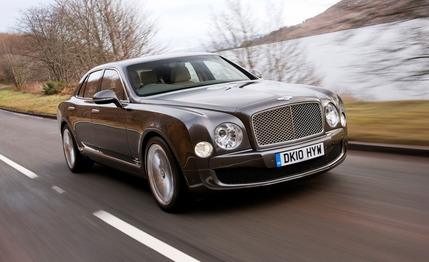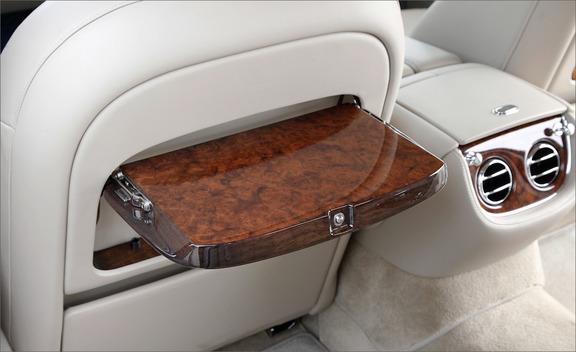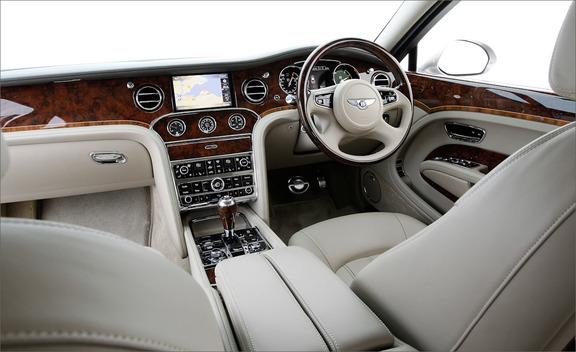 First Drive Review
First Drive Review
It hardly fits the genteel image typically associated with the company, but Bentley’s success in the U.S. is directly attributable to the hip-hop generation’s affection for the Arnage. If rappers like P. Diddy and Jay-Z hadn’t associated that luxury liner with Cristal, Hennessy, and big-time ballin’, who knows whether Bentley would have made the leap from half-dead brand to ultra-luxury car of choice during the past decade.
Unlike the Continental models, which broadened the brand’s appeal and share much of their underpinnings with VW products, the Arnage was developed when BMW was the engine supplier for both Rolls-Royce and Bentley. Introduced in 1998 with a BMW engine—later replaced by Bentley’s own “6¾-liter” twin-turbocharged V-8 when VW acquired the brand—the Arnage was as long in the tooth as the woolly mammoth by the time the 2009 Final Edition was announced. We hear that the VW beancounters wanted Bentley to modify an existing VW Group platform for the Arnage replacement but that Bentley management held out for a unique architecture that plundered the corporate parts bin only where it made sense.
Limited Amount of VW Group Bits
The control-arm front suspension of the new Mulsanne, for instance, is shared with the Audi A8, and the control-arm rear layout comes from the Audi A6 Avant. The HVAC system is an A8 unit, and there is shared electrical architecture with other VW cars, but otherwise, the Mulsanne is all Bentley, designed and built at the company’s spiritual home of Crewe in northern England. The body is manufactured at Crewe, unlike those for the Continental range, which are made in Germany and shipped to England for final assembly. The Mulsanne is a bigger car than the regular-length Arnage, with a 128.6-inch wheelbase and overall length of 219.5 inches, increases of about six and seven inches, respectively. Despite this and a lot more standard equipment, the Mulsanne is 66 pounds lighter than the Arnage, Bentley claims, thanks to the use of aluminum for the car’s doors, hood, and front fenders, as well as composites for the trunk. However, at 5700 or so pounds, the Mulsanne won’t be winning any medals from tree huggers.
Bentley decided to retain the twin-turbo 6.8-liter pushrod V-8 engine that traces its lineage back to 1959. However, it was comprehensively reengineered to meet modern emissions standards and for better fuel economy, which Bentley claims is improved by 15 percent. The block is all-new, even though it retains the same bore centers as the old one. Indeed, the engine has the same 104.2-mm bore and 99.1-mm stroke of the Arnage’s engine, but all the internal parts and the cylinder heads are new. This engine also has cam phasing and cylinder deactivation for the first time. At relatively low engine speeds on part throttle, in fourth gear and above, the V-8 becomes a V-4 by cutting the spark and fuel as well as closing both valves on four cylinders. The engine produces 505 hp at 4200 rpm, up 6 hp on the Arnage T’s version of the engine, and 752 lb-ft of torque at 1750 rpm. This is an increase of 14 lb-ft over the Arnage T mill but delivered 1450 revs earlier. (The version of the V-8 used in the low-production Brooklands is still king, as it makes 530 hp and 774 lb-ft of torque.)
The torque is taken to the rear wheels via a ZF eight-speed automatic transmission, another feature that contributes to the improved gas mileage. There are sport and normal modes, as well as paddles for manual shifting. Bentley uses electronically controlled air springs all around in combination with anti-roll bars, and the suspension is continuously variable. If the computers don’t keep it in the driver’s sweet spot, there are four selectable suspension modes: comfort, which is tuned for a cushy ride and lighter steering efforts; “B,” which is the Bentley engineers’ favored calibration; sport, which has firmer steering and damping; and custom, which allows the driver to mix and match suspension and steering settings. The brake discs are monstrous cast-iron-and-aluminum pieces, 15.7 inches in diameter at the front and 14.6 inches out back. The Mulsanne rides on 20-inch wheels as standard, with 21-inchers on the options list.

More Stylish in Person
All of this is wrapped in brand-new sheetmetal that looks better in the flesh than it does in photographs. The lines are formal and a little bit old-fashioned, inspired by cars such as the 1930 8-Litre sedan that Bentley had at the launch. The car is very regal and has presence, but we really don’t like the googly eyed headlamps that spoil the front end.
Inside, as you’d imagine, the car is exquisite. Large numbers of cows and trees perished in the making of the interior, which features an unbroken ring of wood trim as well as a leather-covered headliner. Our tour guide at the Bentley factory said this car uses three times more wood than previous Bentleys and that 17 to 18 full cowhides are needed per Mulsanne. As well as these natural materials, the cabin features some stunning piano-black finishes and acres of stainless steel. The removable ashtrays are hunks of gleaming metal, and the clip-in rear cup holders are hand-trimmed in leather. Bentley says it takes more than 170 man-hours to craft the interior.
Juxtaposed against the tasteful Old World ambience of the furnishings, the Mulsanne has all the modern technology you’d expect to see in a $285,000 car. There’s a 14-speaker Naim stereo that has a 2200-watt amplifier, as well as a 60-GB hard drive that serves the navigation and audio systems. The rear seats are heated and cooled, recline, and offer a massage feature that put one of our rear-seat riders to sleep.
Among the options are the winged “B” hood ornament, adaptive cruise control, two-tone paint, and rear- and side-view cameras. A 17-speaker Naim stereo is an upgrade, along with a six-DVD player and a rear-seat entertainment system. A potential owner can customize the interior with different veneers, wood inlays, even more luxurious carpets, contrasting color stitching on the leather, and rear-seat picnic tables. We say go whole hog and get the “jewel” fuel-filler cap, contrast seat piping, drilled pedals, and mood lighting, too. All these things are available before you dip into the Mulliner personalization catalog, mind you.

More Rewarding to Drive
On the road, the Mulsanne is a massive improvement over the Arnage and a much sportier vehicle than its direct rival, the Rolls-Royce Phantom. The relatively low-revving V-8 engine is, like a well-behaved child, only heard when it’s asked to be. At cruising speeds, it’s hard to detect that there’s a mechanical device turning up front, but when needed, the V-8 responds with a torrent of torque and a muted growl that signifies some serious get-up-and-go. Bentley claims a 0-to-60-mph time of 5.1 seconds, and the Mulsanne certainly feels that fast. Top speed is claimed to be 184 mph, but one engineer we spoke to said the car actually will get closer to 200 mph.
We detected a slight resonance that signals cylinder deactivation, even if our co-driver didn’t. It’s ever so subtle, and we’d have to say that Bentley has done a great job of masking it, partly by altering the pass-through in the rear mufflers so you can’t hear a change in the exhaust note and partly by using a small amount of torque-converter slip to damp second-order inputs in the drivetrain. The eight-speed transmission swaps gears so smoothly that one can hardly sense upshifts. There’s so much torque on hand that the paddle shifters seem a bit redundant. In sport, the transmission holds onto gears longer.
The car wafts along at 80 mph and higher in virtual silence, with incredible isolation from wind and road noise. Part of that is due to the acoustically treated windows, but the engineers have done an amazing job of reducing wheel and tire impacts. In the comfort setting, the highway ride is glorious, especially in the cavernous rear seats, but the steering in this setting was too light and the ride too pillowy on winding English country roads. We gravitated to a custom setting that married the heftier weight of the sport steering to the “B” suspension setting, which offers a terrific compromise between handling and ride comfort. (The sport setting ties the suspension down more firmly, but the rear-seat ride quality, although still admirable, is notably stiffer.)
The Mulsanne has really accurate and communicative steering and drives small. The most impressive aspect of the handling is how stable it is on corner entry, with body control that would shame many lighter, supposedly sportier vehicles. The brakes, too, are phenomenal, and the car can be hustled at ridiculous speeds, should the mood take you. We suspect that most owners, however, will revel in the luxurious cabin’s ambience as well as the supple ride and the isolation from peasants outside. Bentley plans to sell no more than 800 cars a year worldwide, and it says we should expect to see further variants such as a two-door convertible and a coupe. The Mulsanne goes on sale in the late fall in the U.S. with a base price of $285,000, although we suspect most of them will go out the door for considerably more than 300 large.